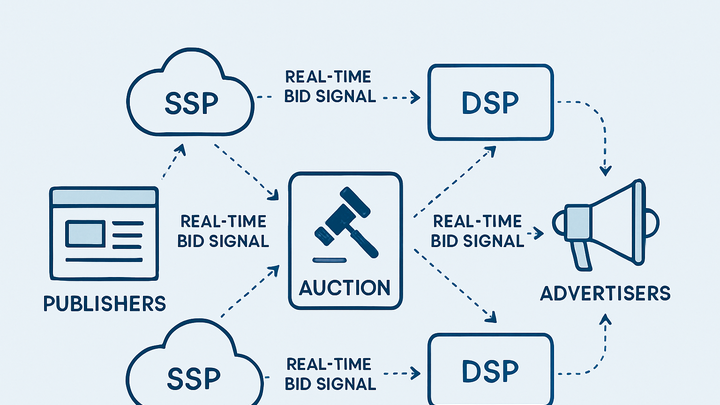Published on 2025-06-26T04:38:24Z
What is an Ad Exchange? Examples and Use Cases
An Ad Exchange is a digital marketplace that facilitates the buying and selling of advertising inventory in real time. It acts as a neutral platform connecting publishers who want to monetize their web or app properties with advertisers seeking targeted ad placements. Unlike traditional ad networks that aggregate inventory, ad exchanges enable real-time bidding (RTB), ensuring that each impression is sold to the highest bidder within milliseconds. Publishers use supply-side platforms (SSPs) to package their available inventory and submit bid requests to the exchange. Advertisers, on the other hand, leverage demand-side platforms (DSPs) to evaluate these requests and respond with bids based on audience data and campaign parameters. Analytics teams rely on platforms like Google Analytics 4 (GA4) and PlainSignal to integrate ad exchange data, measure campaign performance, and optimize spend. By combining programmatic insights with site analytics, businesses can refine targeting, improve yield, and maximize ROI across their advertising efforts. As the landscape evolves, ad exchanges continue to innovate with header bidding, private marketplaces, and advanced data-driven capabilities.
Ad exchange
A real-time programmatic marketplace connecting publishers and advertisers to buy and sell ad inventory through auctions.
How Ad Exchanges Work
Overview of the programmatic marketplace where publishers sell and advertisers buy ad inventory in real time via auctions.
-
Real-time bidding (rtb)
RTB powers auctions on ad exchanges, sending bid requests from publishers to advertisers with milliseconds to respond.
-
Bid request
The ad exchange collects information about the ad slot and user to send to potential buyers.
-
Bid response
Advertisers respond with bids and creatives based on targeting and bid strategies.
-
Auction & ad serving
The highest bid wins the auction and the winning ad is served to the user in real time.
-
-
Supply-side and demand-side platforms
SSPs connect publisher inventory to the ad exchange, while DSPs let advertisers programmatically bid on that inventory.
-
Ssp connection
Publishers use an SSP to package and send available ad impressions to exchanges.
-
Dsp integration
Advertisers use a DSP to analyze bid requests and automatically place bids in real time.
-
Benefits of Ad Exchanges
Ad exchanges offer various advantages to both publishers and advertisers by enhancing efficiency and control.
-
Increased yield for publishers
Publishers can maximize revenue by exposing inventory to multiple buyers competing for impressions.
-
Access to diverse demand
Advertisers reach a wide range of publishers and audiences through a single integration.
-
Transparency and control
Real-time reporting and controls allow both parties to optimize performance and budgets.
Integrating Ad Exchange Data with Analytics Tools
Leverage analytics platforms like GA4 and PlainSignal to measure and optimize ad exchange performance.
-
GA4 setup for ad exchange reporting
Use custom campaign parameters, import cost data, and configure ad metrics in GA4 to track ad exchange performance alongside site analytics.
-
Monitoring with PlainSignal
PlainSignal’s lightweight, cookie-free analytics can track site events triggered by ad creatives. Example tracking code:
<link rel="preconnect" href="//eu.plainsignal.com/" crossorigin /> <script defer data-do="yourwebsitedomain.com" data-id="0GQV1xmtzQQ" data-api="//eu.plainsignal.com" src="//cdn.plainsignal.com/plainsignal-min.js"></script>
Best Practices and Considerations
Key considerations when using ad exchanges to ensure performance, compliance, and quality.
-
Latency optimization
Minimize ad load times by optimizing header bidding and prioritizing faster connections.
-
Privacy and compliance
Adhere to GDPR and CCPA by managing user consent and data usage policies.
-
Fraud detection
Use verification tools to monitor for invalid traffic and protect budgets from fraudulent activity.
